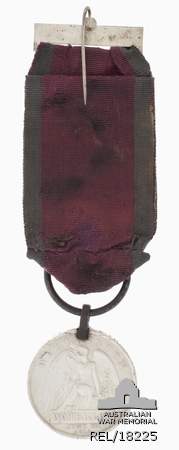| Places | |
|---|---|
| Accession Number | REL/18225 |
| Collection type | Heraldry |
| Object type | Medal |
| Physical description | Silver; steel |
| Maker |
Wyon, Thomas |
| Place made | United Kingdom |
| Date made | c 1816 |
Waterloo Medal : Private W Keevers, 18th Hussars, British Army


Waterloo Medal with a steel clip and suspension ring. The edge of the medal is impressed with the recipients details. Obverse: The profile laureated head of the Prince Regent with the legend 'GEORGE P. REGENT' around the edge and the designer's name 'T WYON' under the neck. Reverse: The winged figure of Victory seated on a pedestal and holding a palm branch in her right hand and an olive branch in her left; below the pedestal is the word 'WATERLOO' within a rectangle over the date June 18 1815. The word 'WELLINGTON' is in raised letters above the winged figure around the rim. The steel clip has been replaced and riveted to the disc. A piece of 42 mm wide ribbon of crimson with dark blue edges is threaded through the steel suspension ring and has an ornate silver scroll stick pin brooch bar at the top of the ribbon.
840 Corporal William Keevers was born in Margate, Kent, England, on 11 March 1790 to Edward and Mary Keevers. He was working as a labourer when he enlisted with the 18th (King’s Irish) Regiment (Light) Dragoons (Hussars) in December 1810. He travelled with the regiment to Portugal in February 1813 to take part in the Peninsula War against Napoleon Bonaparte’s French forces. The regiment stayed with the army of Sir Arthur Wellesley throughout the campaign taking part in some of the key battles at Vittoria and Toulouse. When Napoleon returned from his exile on Elba in 1815, Private Keevers and the regiment returned to France. They took an active part in the decisive Battle of Waterloo and were kept in France as part of the army of occupation for two years.
In 1819 Keevers married Sarah Slack of Kent in England. Their first child, Jane, was born on 13 April 1821, but died just over a year later. In 1821 the 18th (King’s Irish) Regiment (Light) Dragoons (Hussars) was disbanded. William then joined his younger brother Edward Keevers in the 3rd (Kent) Regiment of Foot 'The Buffs' in June 1822. The regiment was posted to Australia and set sail in November 1822. Private Keevers travelled with his pregnant wife to Australia where he and his brother were posted to Van Diemen’s Land. They arrived at Hobart on 13 of March 1823, the same day that Sarah gave birth to their first son, James. Edward Keevers died on 1 October 1824 while still serving in Hobart. William Keevers was promoted to Corporal on Christmas Day, 1826.
By 1827 Corporal Keevers had been ordered to Sydney where he was seconded into the newly formed New South Wales Military Mounted Police. Shortly after joining the Mounted Police his original unit, 'The Buffs' was ordered to India. To stay in Australia, with the Mounted Police Corporal Keevers transferred to the 57th (West Middlesex) Regiment of Foot. He transferred again in January 1831 when that unit was ordered to India, this time to the 17th (Leicestershire) Regiment of Foot.
Keevers was discharged in September 1833 and received a 100 acre land grant at West Dapto near Wollongong. He named his farm 'Hussar Farm' and lived there until 1845 when he sold the farm to his neighbour and moved to Jamberoo near Kiama. He died at Jamberoo in November 1871 as a result of a fall he sustained during a visit to the town by the Governor of New South Wales. He was survived by his wife and ten children.
The medal appears to be renamed with the recipient’s details using engraving rather than the original impressing. The engraving incorrectly lists Keevers as a Corporal when in fact he was a Private during the Battle of Waterloo. The medal may be an early replacement or a ground down original renamed to Keevers’ specification showing his higher rank.